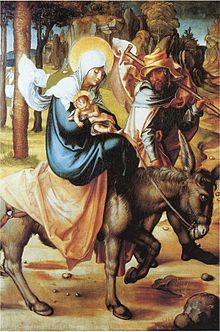Escape to Egypt


The flight into Egypt is an event from the childhood of Jesus , described in the Gospel of Matthew ( Mt 2,13 ELB ). Apocryphal writings such as the pseudo-Matthew Gospel and the Arabic Gospel of Childhood also tell of the miracles of the young Jesus. The Legenda aurea mentions something similar .
The flight is one of the Seven Sorrows of Mary , commemorated in the Catholic liturgical calendar on September 15th. According to traditional martyrologies , the return from Egypt was commemorated on January 7th at the latest since the 9th century .
Gospel of Matthew
After the wise men had left the Orient , an angel appeared to Joseph in a dream. He ordered him to flee to Egypt with Mary and Jesus because Herod wanted to kill the child. There he should wait for more news. After Herod's death, the angel reappeared and told Joseph to return. But since Herod's son Archelaus was ruler over Judea , Joseph was afraid. According to divine instruction, he and his family moved to Nazareth in Galilee .
The evangelist relates the return of Jesus to the exodus of the people of Israel from Egypt : and he was there until Herod's death; so that what was spoken of the Lord through the prophet would be fulfilled, who said: "Out of Egypt I have called my son" ( Mt 2,15 ELB ). It refers to a verse in the book of Hosea : When Israel was young I loved it, and from Egypt I called my son. ( Hos 11 : 1 ELB ) Originally, "Son of God" therefore meant the people of Israel .
Extra-Biblical Reports
According to the apocryphal pseudo-Matthew Gospel, Joseph was accompanied by three boys and Mary by a girl. The child Jesus is said to have performed numerous miracles during and after the flight: Dragons fell down in homage to him and a date palm bowed to Mary and then released a spring on its trunk. When the family arrived in the Egyptian city of Sotinen, they did not know where to find shelter. When Mary entered a temple with the baby Jesus, 365 images of gods toppled over. The priest and the people of the city were converted according to this sign.
According to the Arabic Gospel of Childhood , the family went to a hospital dedicated to the supreme Egyptian god. The earth shook and the god announced to the terrified Egyptians that this was happening because a true God had come to whom all must submit. Then the talking idol collapsed.
According to the Legenda aurea (chapter: "Of the innocent children") a medicinal tree called Persidis was bowed before the Lord in Hermopolis in the Thebais . Moreover, there was a broken idol in every Egyptian temple.
Four children accompany the Holy Family ( Giotto di Bondone )
The images of the gods fall in the temple ( Jerg Ratgeb , around 1520)
Significant representations in art
- Landscape with the Flight into Egypt , Pieter Bruegel the Elder , 1563
- Rest on the Flight into Egypt (Caravaggio) , Michelangelo Merisi da Caravaggio , around 1594
- The Flight into Egypt (around 1605) , Adam Elsheimer , around 1605
- The Flight into Egypt (1609) , Adam Elsheimer , 1609
See also
Individual evidence
- ^ Mary - "Dolores" - Seven Sorrows of the Blessed Virgin Mary in the Ecumenical Lexicon of Saints , accessed on February 21, 2012
- ^ Ferdinand Pieper: The calendars and martyrologies of the Anglo-Saxons. Berlin 1862, p. 14 ( digitized version ).
- ↑ Henning Graf Reventlow : Epochs of Biblical Interpretation Volume I: From the Old Testament to Origen. CH BECK 1990, ISBN 978-3-406-34663-7 , p. 70
- ↑ a b Pseudo-Matthew Gospel (accessed on February 17, 2012)
- ^ Jacobus de Voragine - The Legenda Aurea , translated by Richard Benz. 15th edition, Gütersloher Verlagshaus, 2007, ISBN 978-3-579-02560-5 (Chapter: From the innocent little children , p. 58)
Web links
- Wolfgang Augustyn: Escape to Egypt . In: Reallexikon zur Deutschen Kunstgeschichte , Volume IX (2001), Sp. 1352–1432.




